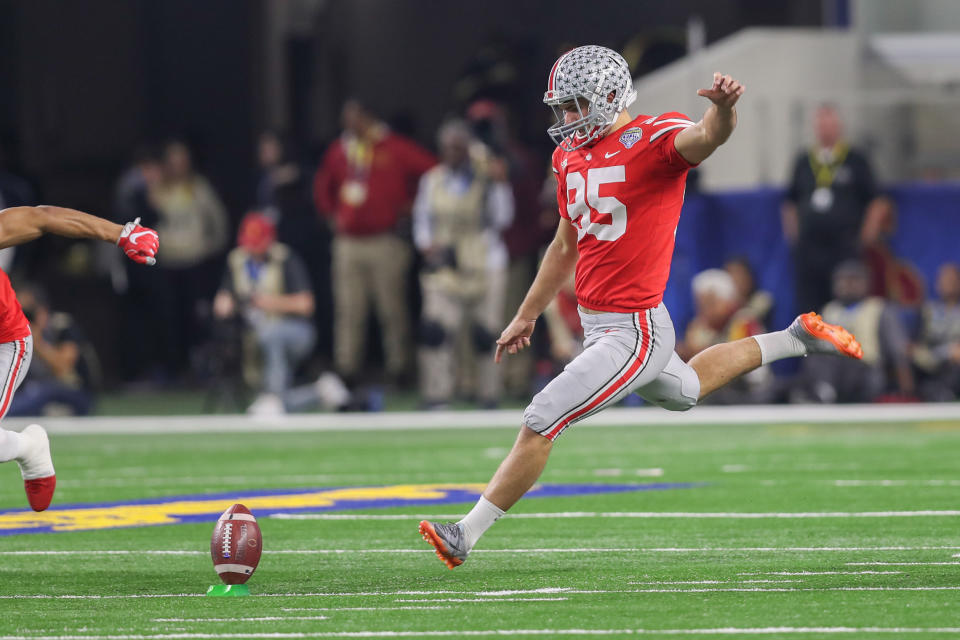NCAA rules committee proposes drastic overhaul to kickoff returns

Kickoffs in college football could look a lot different in 2018.
Currently, any player who taking a knee or calling for a fair catch in the end zone on a kickoff results in a touchback and the ball spotted at the 25-yard-line for the offense. Under a recommendation from the NCAA’s rules committee, a player could call for a fair catch anywhere inside the 25-yard-line and the result of the kick would be a touchback and the ball would be brought out to the 25.
The rule would be designed to lessen the number of kickoff returns, which are considered some of the most dangerous plays in football.
“The committee discussed the kickoff play at great length and we will continue to work to find ways to improve the play,” North Carolina coach Larry Fedora, the chair of the committee, said in an NCAA statement. “We believe making one change will allow us to study the effect of this change in terms of player safety.”
The NCAA moved kickoffs from the 30 to the 35 and the touchback starting spot from the 20 to the 25 in 2012 in an attempt to lessen the number of kickoff returns in a game. The thought was that an extra five yards forward for the tee would allow more kickers to get the ball into the end zone and the extra five on the touchback would serve as an incentive for returning teams to down the ball.
But some teams realized they could pin their opponents inside the 25 by kicking short of the end zone and forcing teams to return the ball. After all, a kicking team can recover an untouched kickoff and gain possession.
The recommendation is not final. It will be voted upon in April by the NCAA Playing Rules Oversight Panel. But given that it’s an official recommendation, there’s a good chance it could pass and become a rule.
It’s an out-of-the-box idea that could have some serious potential in accomplishing the goal of fewer kick returns. Bill Connelly of College Football Study Hall dug into the data after the most recent rule change and noted that touchbacks went up from approximately 15 percent to 34 percent in the first year of the rule.
It’s a significant difference. But a lot has changed in five seasons, both in player safety awareness and in analytical advancement. Teams got better at attempting to pin their opponents deep in their own territory.
How will they try to game this system? Will returning teams take touchbacks early in the game in the hopes of luring their opponents to sleep? Will teams take touchbacks when catching the ball inside of the 10 but not outside of it? Eighty-five of 129 FBS averaged over 20 yards per kickoff return. That’s obviously not directly applicable to the new set of potential rules, but it could influence some teams’ thinking as to when and where they want to return kicks if and when this recommendation becomes a rule.
Other rule changes recommended by the committee:
• A rule that would limit the number of blocks below the waist has advanced into a recommendation. After debating limiting low blocks more than 10 yards downfield, the committee is recommending banning low blocks more than five yards downfield.
• The play clock would start at 40 seconds immediately after a touchdown for the ensuing conversion and at 40 seconds as soon as a kickoff play has ended.
• A 10-second runoff would be applied if an instant replay review overturns a call on the field inside the final minute of a half and the ruling means the clock would not have stopped. As an example, if a runner is ruled out of bounds and replay determines that his knee was down before he stepped out, a 10-second runoff would happen.
• If a defensive team commits a personal foul penalty on a good field goal, the kicking team will have the option of assessing it on the kickoff.
• Leaping penalties on field goals and extra points would be tweaked to mimic the leaping rule on punts, where it’s illegal to leap over the frame of the body of an opponent.
– – – – – – –
Nick Bromberg is a writer for Yahoo Sports.



